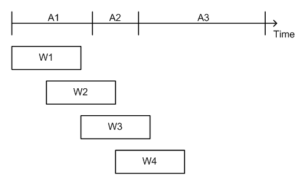Window size in (acceleration) signal segmentation for activity classification is important because it needs to capture necessary characteristics of the signals. Various sizes of window have been used in previous works without stating a specific reason. A window size is selected based on past experiments and hardware limitations. Majority of approaches used window size in the range of 1s to 6.7s while a few of them used larger window size such as 10s and 12.8s [1]–[4]. Short windows could slice an activity signal into multiple separate windows. Thus a truncated signal lacks the full information to describe the activity. On the other hand, larger window size could contain multiple activity signals which could also lead to misinterpretation of physical activities. The most effective window size depends on the type of signals being evaluated because different activities have different periods of motion. The scenario is shown in Figure 1. The signal contains three activity signals (A1, A2 and A3) with varying length. The fixed sliding window with 50% overlapping is employed to classify the activities. As shown in Fig. 1, only signal A2 is shorter than the window size while signals A1 and A3 are longer. Therefore, the signals are not fully segmented by window W1, W2 and W4. In both cases, misclassification could happen because the windows do not have optimal information of the signals. Evidently, a sliding window with a fixed size is not an effective approach for activity recognition system. A new signal segmentation technique which can dynamically adapted the window size is required to effectively segment the different activity signals.

Figure 1: Activity classification with fixed sliding window.
Gupta and Dallas [5] introduced new features to effectively capture the characteristics of transitional activities: stand-to-sit/sit-to-stand and stand-to-kneel-to-stand. Although the results are excellent, misclassification can still happen especially from transitional events, i.e. sit-to-stand into walking. The author explained that, these events were not classified in isolation but contained some walking signals. It is also explained, misclassification is likely happen if the transition events is completed very quickly because the window being evaluated contains big portion of data from walking. Furthermore, stand-to-sit and sit-to-stand are not distinguished by the system in which the activities are classified as a single class (sit-to-stand/stand-to-sit).
[1] S. Bersch, D. Azzi, R. Khusainov, I. Achumba, and J. Ries, “Sensor Data Acquisition and Processing Parameters for Human Activity Classification,” Sensors, vol. 14, no. 3, pp. 4239–4270, Mar. 2014.
[2] S. J. Preece, J. Y. Goulermas, L. P. J. Kenney, D. Howard, K. Meijer, and R. Crompton, “Activity identification using body-mounted sensors—a review of classification techniques,” Physiol. Meas., vol. 30, no. 4, p. R1, Apr. 2009.
[3] B. Fida, I. Bernabucci, D. Bibbo, S. Conforto, and M. Schmid, “Varying behavior of different window sizes on the classification of static and dynamic physical activities from a single accelerometer,” Med. Eng. Phys., vol. 37, no. 7, pp. 705–711, Jul. 2015.
[4] O. Banos, J.-M. Galvez, M. Damas, H. Pomares, and I. Rojas, “Window Size Impact in Human Activity Recognition,” Sensors, vol. 14, no. 4, pp. 6474–6499, Apr. 2014.
[5] P. Gupta and T. Dallas, “Feature Selection and Activity Recognition System Using a Single Triaxial Accelerometer,” IEEE Transactions on Biomedical Engineering, vol. 61, no. 6, pp. 1780–1786, Jun. 2014.